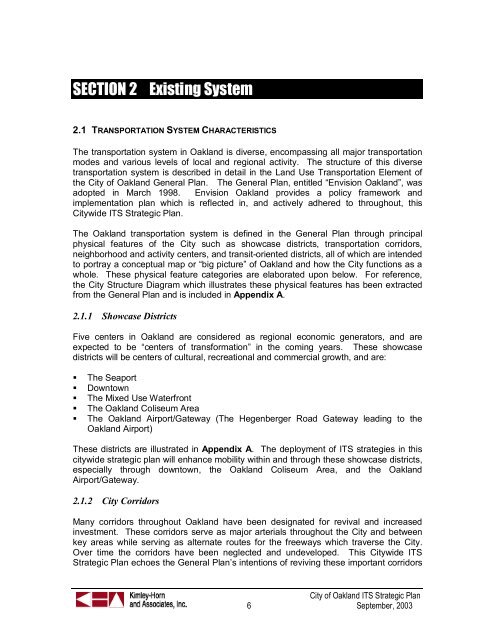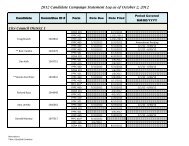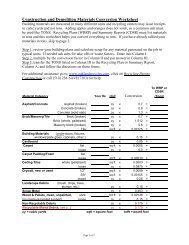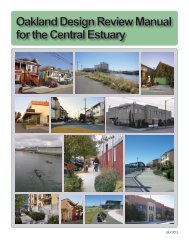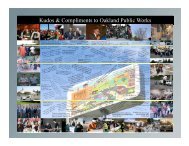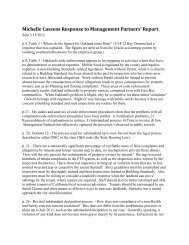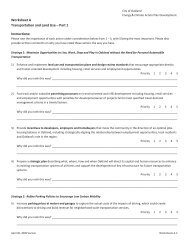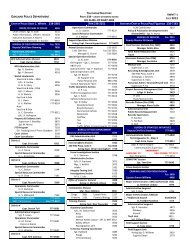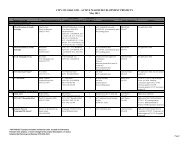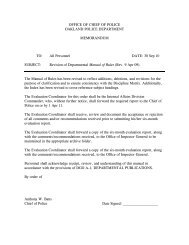Intelligent Transportation Systems - City of Oakland
Intelligent Transportation Systems - City of Oakland
Intelligent Transportation Systems - City of Oakland
Create successful ePaper yourself
Turn your PDF publications into a flip-book with our unique Google optimized e-Paper software.
SECTION 2<br />
Existing System<br />
2.1 TRANSPORTATION SYSTEM CHARACTERISTICS<br />
The transportation system in <strong>Oakland</strong> is diverse, encompassing all major transportation<br />
modes and various levels <strong>of</strong> local and regional activity. The structure <strong>of</strong> this diverse<br />
transportation system is described in detail in the Land Use <strong>Transportation</strong> Element <strong>of</strong><br />
the <strong>City</strong> <strong>of</strong> <strong>Oakland</strong> General Plan. The General Plan, entitled “Envision <strong>Oakland</strong>”, was<br />
adopted in March 1998. Envision <strong>Oakland</strong> provides a policy framework and<br />
implementation plan which is reflected in, and actively adhered to throughout, this<br />
<strong>City</strong>wide ITS Strategic Plan.<br />
The <strong>Oakland</strong> transportation system is defined in the General Plan through principal<br />
physical features <strong>of</strong> the <strong>City</strong> such as showcase districts, transportation corridors,<br />
neighborhood and activity centers, and transit-oriented districts, all <strong>of</strong> which are intended<br />
to portray a conceptual map or “big picture” <strong>of</strong> <strong>Oakland</strong> and how the <strong>City</strong> functions as a<br />
whole. These physical feature categories are elaborated upon below. For reference,<br />
the <strong>City</strong> Structure Diagram which illustrates these physical features has been extracted<br />
from the General Plan and is included in Appendix A.<br />
2.1.1 Showcase Districts<br />
Five centers in <strong>Oakland</strong> are considered as regional economic generators, and are<br />
expected to be “centers <strong>of</strong> transformation” in the coming years. These showcase<br />
districts will be centers <strong>of</strong> cultural, recreational and commercial growth, and are:<br />
• The Seaport<br />
• Downtown<br />
• The Mixed Use Waterfront<br />
• The <strong>Oakland</strong> Coliseum Area<br />
• The <strong>Oakland</strong> Airport/Gateway (The Hegenberger Road Gateway leading to the<br />
<strong>Oakland</strong> Airport)<br />
These districts are illustrated in Appendix A. The deployment <strong>of</strong> ITS strategies in this<br />
citywide strategic plan will enhance mobility within and through these showcase districts,<br />
especially through downtown, the <strong>Oakland</strong> Coliseum Area, and the <strong>Oakland</strong><br />
Airport/Gateway.<br />
2.1.2 <strong>City</strong> Corridors<br />
Many corridors throughout <strong>Oakland</strong> have been designated for revival and increased<br />
investment. These corridors serve as major arterials throughout the <strong>City</strong> and between<br />
key areas while serving as alternate routes for the freeways which traverse the <strong>City</strong>.<br />
Over time the corridors have been neglected and undeveloped. This <strong>City</strong>wide ITS<br />
Strategic Plan echoes the General Plan’s intentions <strong>of</strong> reviving these important corridors<br />
<strong>City</strong> <strong>of</strong> <strong>Oakland</strong> ITS Strategic Plan<br />
6 September, 2003


